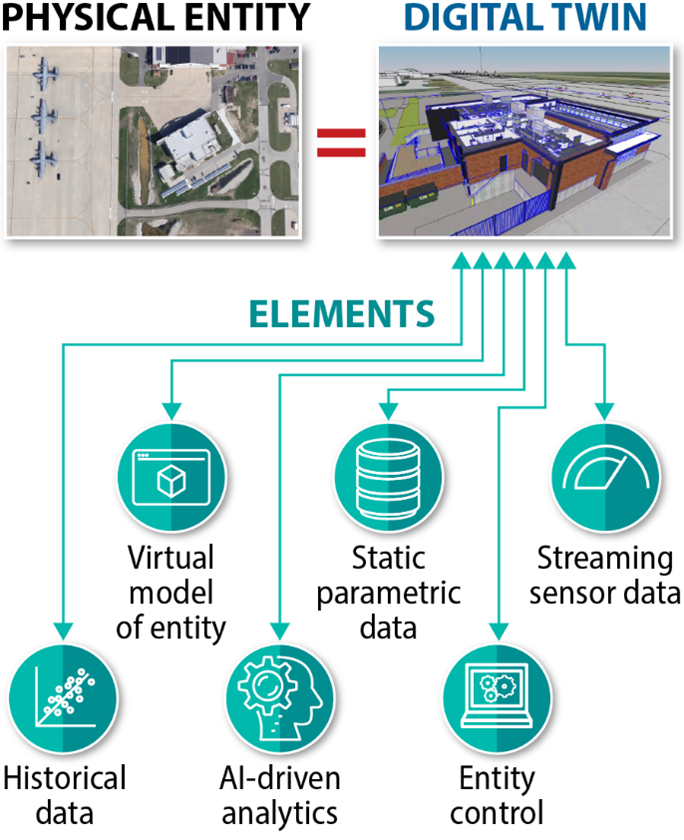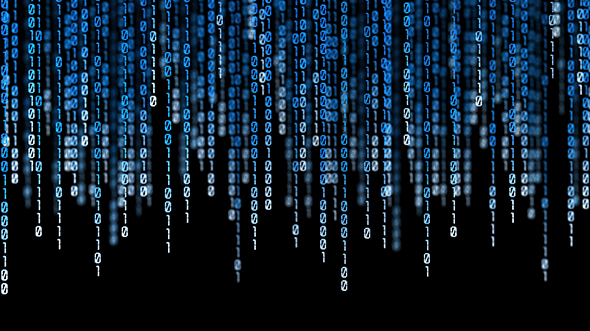
BLOG
—
The term digital twin is everywhere. It would seem that every software company’s flagship product is—all of a sudden and through some miracle of marketing—a digital twin platform. So, what really is a digital twin? According to the Digital Twin Consortium, a digital twin is a virtual representation of real-world entities and processes, synchronized at a specified frequency and fidelity. To expand on this definition, digital twins use static, streaming, and historical data to mirror the past and present as well as artificial intelligence to simulate predicted futures. A digital twin is intended to be a fast, efficient, low-risk way to decide and enact potential future actions in a virtual copy of a system before taking any action within the actual physical system.
A fully developed digital twin should include each of the following elements: a model, static data, streaming data, historical data, AI, and entity control. Let’s take a closer look at each of these elements and their function in the digital twin.
- Model: This element of the twin is a virtual, typically spatial, object-based representation of the asset, system, process, or facility. The functional purpose of the model element of a digital twin is twofold. First, it supplies data related to how components of an asset, system, or process are organized and situated in relation to each other, typically in physical space, which could provide valuable context in the analysis of the behavior of the entity being twinned. Second, it has become one of the most successfully adopted means for structuring user interfaces to a digital twin. People really seem to like interacting with graphics over text.
- Static data: Every digital twin will have some amount of static parametric data that represents the physical characteristics of the asset, system, process, or facility. Similar to the model element, static parametric data is important for understanding the baseline design of the entity being twinned. This will provide important inputs to the analysis of how the entity might behave in certain conditions. The static parametric data is also important in identifying and distinguishing specific components within the digital twin.

- Streaming data: Streaming data is a real-time, or at least frequency-based, feed of contextual, condition, and/or performance data from Internet of Things-connected sensors installed on the asset, system, process, or facility. This data can take the form of anything that is variable and measurable, including, but not limited to: temperature, humidity, pressure, vibration, electrical current, motion, sound, or even the presence of gasses or liquids. The presence of streaming data is a key differentiator between what would be considered simply a digital as-built or digital model from a true digital twin. Streaming data is important to digital twins because predicting how a physical entity will behave in the future is as much a product of the forces acting on and around the entity as it is the physical characteristics of the entity itself.
- Historical data: The final part of the digital twin related to data inputs is historical data. Just as it is important that a digital twin know the current physical and contextual characteristics of an asset, system, process, or facility, it is also important for the twin to know what these characteristics were in the past. Specifically, knowing what these characteristic values were when certain events (like failures) occurred is integral to building a profile that will allow the twin to predict what certain events (positive or negative) may occur as those characteristics change again in the future. In most cases, simply knowing what an entity looks like right now will not be sufficient in analyzing what might happen to it in the future. The historical data available to a digital twin serves to provide a means of correlation between various data inputs to the model.
- Artificial intelligence: AI refers to computer systems that can perform tasks that typically require human-like intelligence, such as visual perception, speech recognition, decision-making, and natural language processing. The importance of AI in digital twin design is AI’s ability to be more efficient, consistent, scalable, objective, and adaptable than humans in the context of data-driven decision-making. The AI component of a digital twin synthesizes all the data inputs defined above to predict potential future outcomes and to decide the next right things to do in relation to a physical asset, system, process, or facility. AI is the secret sauce of a digital twin and the most defining feature that separates digital models from true digital twins.
- Entity control: The final element of a fully mature digital twin is the ability of the twin to interact with software, logic controllers, actuators, motors, and other components that are connected by IoT to the physical entity for the purpose of autonomously executing the prescribed actions. The complete transformative result of a digital twin is realized when the twin is capable of continuously working in an optimized manner with no direct human intervention.
While the above elements are what make up a digital twin, the simple presence of each of the elements alone does not provide any measure of the digital twin’s value. A digital twin is created to directly influence business outcomes. Specifically, digital twins exist to improve the efficiency and resilience of a physical system or process or to generate new revenue streams. This definition places more significance on the analytical aspect of the digital twin versus the visual representation. As such, we are better served by looking at digital twins as programs or approaches to business operations versus stand-alone, discrete, information technology platforms or software solutions. Unfortunately, this does mean that many software companies touting digital twin solutions are using the term incorrectly or, at least, insufficiently. However, this should not diminish their potential value as a part of an effective digital twin solution. Only analysis of your own business needs and use cases can supply the proper context to complete the definition of what an effective digital twin is for your situation.
Share this Post



